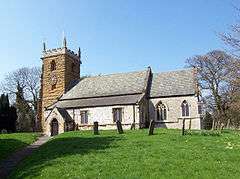Wootton, Lincolnshire
Wootton is a small village and civil parish in North Lincolnshire, England. The population of the civil parish at the 2011 census was 475.[1] It is situated 5 miles (8 km) south-east from Barton-upon-Humber, 7 miles (11 km) north-east from Brigg and 3 miles (5 km) north from Humberside Airport.
| Wootton | |
|---|---|
 St Andrew's Church, Wootton | |
 Wootton Location within Lincolnshire | |
| Population | 475 (2011) |
| OS grid reference | TA090162 |
| • London | 145 mi (233 km) S |
| District | |
| Shire county | |
| Region | |
| Country | England |
| Sovereign state | United Kingdom |
| Post town | Ulceby |
| Postcode district | DN39 |
| Police | Lincolnshire |
| Fire | Lincolnshire |
| Ambulance | East Midlands |
| UK Parliament | |
History
A large mound, locally known as Galley Hill, has been designated a Scheduled monument as it is believed to be a Bronze Age Round barrow dating from 2600 to 700 B.C.[2]
A unique Romano-British linchpin, in the form of an upright thumb, was found by an agricultural worker in the 1980s. It was purchased by the North Lincolnshire Museum.[3]
Wootton is an Anglo-Saxon settlement and is recorded in the Domesday Book as "Udetune".[4] Inhabited by 8 villagers, 7 smallholders and 71 freemen, in over 40 households, it was considered 'very large'.[5] The lordship of the manor was jointly held by Odo of Bayeux, a half-brother of William the Conqueror and Ralph de Mortimer, with Mortimer the tenant-in-chief.[5]
The Anglo-Saxon church of St Andrew is constructed of stone in Early English style, and was restored in 1851.[6]
To the North of the village is the Grade II* listed Wootton Hall which was built in 1796 for John Uppleby.[6][7] Surrounding structures including a house (formerly one of a pair),[8] a barn,[9] the hall gates,[10] and stables and other outbuildings, [11] are also Grade II listed with English Heritage.
There was a village windmill on Green Lane, but it was demolished in the mid-20th century.
Community
The 2001 Census recorded 492 residents in the parish of Wootton, inhabiting 216 properties.[12]
The village is surrounded by arable land and has retained its character as a result of its designation as a "limited growth settlement" by North Lincolnshire Council. It is known locally for its large pond,[6] which lies at the eastern end of the village. Whilst there is no longer a village shop or post office, there is a village hall, a small primary school,[13] and a public house – the Nags Head. The village water pump has recently been restored and is located on High Street.
Wootton came second in the Campaign to Protect Rural England's 2009 Best Kept Village competition.[14]
References
- "Civil parish population 2011". Neighbourhood Statistics. Office for National Statistics. Retrieved 20 April 2016.
- Historic England. "Galley Hill barrow (78788)". PastScape. Retrieved 15 November 2014.
- Parker, A; McKie, S (2019). "Hitching a Lift: Functional Context and Magical Symbolism in a Roman Linchpin from Wootton, North Lincolnshire". Britannia. 50. doi:10.1017/S0068113X19000096.
- "Wootton". The Historical Gazetteer of England's Place-Names. Retrieved 15 November 2014.
- Wootton in the Domesday Book
- "Kellys Directory 1919". Kellys Directories Ltd. p. 614. Retrieved 20 April 2011.
- Historic England. "Wootton Hall (1204691)". National Heritage List for England. Retrieved 15 November 2014.
- Historic England. "House approximately 45 metres East of Wootton Hall (1103690)". National Heritage List for England. Retrieved 15 November 2014.
- Historic England. "Barn approximately 45 metres East of Wootton Hall (1103691)". National Heritage List for England. Retrieved 15 November 2014.
- Historic England. "Gates at Wootton Hall (1204697)". National Heritage List for England. Retrieved 15 November 2014.
- Historic England. "Stables and outbuildings at Wootton Hall (1103689)". National Heritage List for England. Retrieved 15 November 2014.
- "Wootton". North Lincolnshire Council. Retrieved 15 November 2014.
- "Wootton St Andrew's Church of England Primary School". North Lincolnshire Council. Retrieved 15 November 2014.
- "BYGONES: Reflecting on changes". Grimsby Telegraph. 16 December 2011. Retrieved 15 November 2014.
External links
